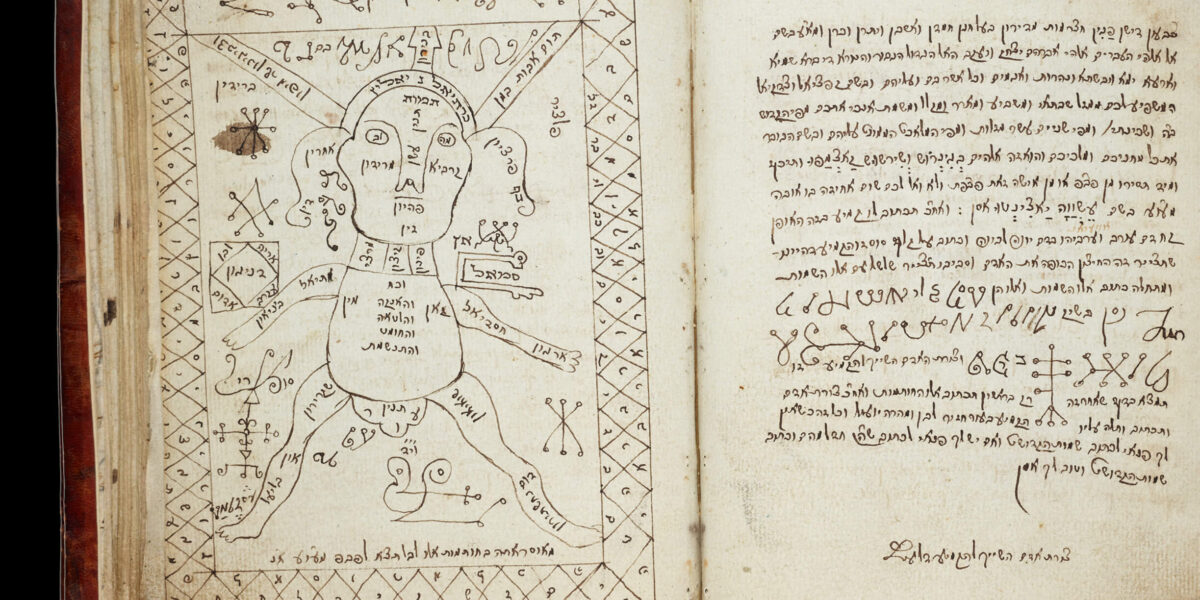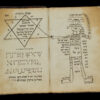The most important manuscript known today on remedies, segulot and practical kabbalah from Ashkenazic countries, Eastern Europe, ca. first half of 18th C.
An encyclopedic compendium of practical kabbalah of tremendous scope: remedies, segulot, protections, amulets, hashbaot and goralot; includes thousands of alphabetical entries, with much information not known from any other source, with numerous diagrams and illustrations. [Eastern Europe, ca. first half of 18th century].
It is the most important manuscript known today on remedies, segulot and practical kabbalah from Ashkenazic countries, superior in its scope and quality to all manuscript compendiums and printed works on these topics. It includes rare material, some of which does not appear in any other source, and bears witness to the medical knowledge, segulot, amulet texts, incantations and hashbaot used by the Baalei Shem (healers) of that period – in the time of the Baal Shem Tov. The exceptional significance of this manuscript also lies in its early mentions of the Baal Shem Tov, and in the explicit documentation it provides of the kabbalistic secrets which the Baal Shem Tov received from R. Adam Baal Shem – a fact hitherto undocumented in research literature.
The main part of the manuscript – leaves 1-240 – was written by a skilled scribe, who compiled thousands of prescriptions and texts from various sources, and arranged them alphabetically in chapters. Neat Ashkenazic script, with many precise and beautiful, masterfully drawn diagrams and illustrations. Additions were later inserted by various writers in different places in the manuscript and in the blank leaves that remained. Later leaves were also bound with the manuscript. It is evident that the manuscript served several generations of folk healers and Baalei Shem, and was passed on from one to the other for practical use. The manuscript comprises thousands of entries covering a wide range of topics, including: texts of amulets, hashbaot and incantations for various matters – protection of the home, against thieves, fire and demons; protection for journeys, from enemies, wild beasts, bandits and sorcerers; hashbaot for kefitzat haderech (miraculous travel between two distant places in a brief time); amulets and segulot for pregnancy, easy birth, protection for the mother and baby; remedies and segulot for a wide range of illnesses and ailments; instructions for uncovering hidden matters and future events, to become invisible, and more; annulling sorcery, evil spirits and evil eye; amulets and hashbaot against dybbuk; hashbaot of angels and demons; goralot (lots); segulot for plentiful livelihood and wealth; and many more topics. The manuscript also includes rare, detailed instructions on how to create a Golem (p. 237a). This section concludes with a warning that it should only be done in case of great necessity. In many places, the writer notes “tried-and-true”.
On a few occasions, the writer mentions his sources. He quotes several times the kabbalist R. Naftali Katz author of Semichat Chachamim (who passed away in 1719; for instance: “In the name of the prominent Torah scholar”, the late R. Naftali Katz – p. 173b). The latest book he quotes (p. 41a) is the book Amtachat Binyamin by R. Binyamin Benush son of R. Yehuda Leib HaKohen (printed in Wilhelmsdorf 1716). On pp. 22a and 88b, he mentions R. Eliyahu Baal Shem, rabbi of Chelm. On p. 158b, he cites the expert physician R. Daniel Doktor. On p. 34b there is a mention of the “expert and renowned physician, R. Yitzchak Chazak of Reisha”. R. Yitzchak Chazak, mentioned here with the blessing for the living, is R. Avraham Yitzchak Chazak Fortis, representative of the Vaad Arba Aratzot (Council of Four Lands) and leader of the community of Reisha (Rzeszów) in the first half of the 18th century. His signature appears on decisions of the Vaad Arba Aratzot, dated 1718-1730. He first lived in Lviv and Jarosław, and later settled in Reisha as the physician of Prince Lubomirski of Reisha and Count Potocki of Lizhensk. R. Yaakov Emden mentions him in his book Edut BeYaakov, Altona 1856, p. 66a (see: Yisrael Heilperin, Pinkas Vaad Arba Aratzot, index). However, the most important source quoted in the present manuscript is undoubtedly the Baal Shem Tov. Kabbalistic Secrets Transmitted by R. Adam Baal Shem to the Baal Shem Tov – Important, Hitherto Unknown Historical Documentation. On pp. 118b-119b, there is a long section containing an extensive series of procedures, hashbaot and texts to recite, for healing a sick person. The source is noted at the end: “From the writings of R. Yisrael Baal Shem, transmitted to him by R. Adam Baal Shem, who received from Gur Aryeh”. This record is of unparalleled importance, as it documents the transmittal of kabbalistic secrets from R. Adam Baal Shem to the Baal Shem Tov. This documentation is of great significance for the study of the biography of the Baal Shem Tov. The name of R. Adam Baal Shem is known to us from the book Shivchei HaBaal Shem Tov (first printed in Kopust 1815), which states that the Baal Shem Tov received kabbalistic secrets from the son of R. Adam Baal Shem. Researchers and historians tried to identify R. Adam Baal Shem, and many articles were written on this topic, containing divergent opinions on the matter. Horodezky doubted the existence of R. Adam Baal Shem. Prof. Scholem identified him as R. Heshel Tzoref, and claimed that the authors of Shivchei HaBaal Shem Tov concealed his identity due to his ties to Sabbateanism. Prof. Shmeruk later discovered an earlier source than Shivchei HaBaal Shem Tov mentioning R. Adam Baal Shem – a booklet in Yiddish featuring stories about R. Adam Baal Shem. According to Shmeruk, this booklet was printed in Prague in the 17th century. The booklet indicates that R. Adam Baal Shem lived in Prague, and describes his meeting with Emperor Maximillian II. This emperor reigned in 1564-1576, during the Maharal’s tenure as rabbi of Prague. Prof. Shmeruk thereby contradicted the statement of Prof. Scholem, and claimed that the authors of Shivchei HaBaal Shem Tov knew of R. Adam Baal Shem from the 17th century booklet and connected his name with that of the Baal Shem Tov (the various opinions on this topic are presented in: David Assaf and Esther Liebes [editors], The Latest Phase: Essays on Hasidism by Gershom Scholem, Jerusalem 2008, pp. 41-47, and in the addendums there, pp. 56-63). All assumptions up until now were based on one source only, and that is the mention of the name R. Adam Baal Shem in Shivchei HaBaal Shem Tov. This is however a new, contemporary, hitherto unknown source, which mentions the relationship between the Baal Shem Tov and R. Adam Baal Shem explicitly. It furthermore reports in detail the actual teachings the Baal Shem Tov received from him. This source, which was not known to researchers, is of invaluable importance for the study of the Baal Shem Tov’s biography and in particular his relationship with R. Adam Baal Shem. The present manuscript is worthy, in this context as well, of its own comprehensive scholarly analysis. It must be noted that assuming R. Adam Baal Shem quoted in this manuscript is indeed R. Adam Baal Shem of Prague mentioned in the 17th century booklet, one can conjecture that “Gur Aryeh” mentioned here is in fact the Maharal of Prague, in which case this manuscript documents an interesting chain of transmission of practical kabbalah:
“From the writings of R. Yisrael Baal Shem [=the Baal Shem Tov], transmitted to him by R. Adam Baal Shem, who received from Gur Aryeh [=the Maharal of Prague].
The book Shivchei HaBaal Shem Tov relates that the Baal Shem Tov hid his writings in a stone in the mountain, and quotes the reprover of Polonne who stated in his old age that although he was capable of retrieving the writings, as he was aware of their location, he did not wish to go against the wishes of the Baal Shem Tov. He also attested that these writing had been in the hands of Avraham Avinu and Yehoshua Bin Nun (Shivchei HaBaal Shem Tov, Rubinstein edition, p. 59). The present manuscript also serves as an early record of the existence of these “writings of the Baal Shem Tov”. An Additional Mention of the Baal Shem Tov (“Protection for the Home by R. Yisrael Baal Shem Tov”) – Source of the Amulet of R. Yeshaya of Kerestir – The Manuscript Amongst the Groups of Disciples of the Baal Shem Tov Detailed instructions for protection of the home, including amulets and other procedures, are scribed on leaf [18] – one of the later leaves bound at the beginning of the manuscript. Stated at the top of the page: “Protection for the home by the late R. Yisrael Baal Shem Tov”. This inscription attests that the manuscript was in the possession of the first groups of the Baal Shem Tov’s Chassidim. An interesting fact revealed here for the first time is that the famous amulet attributed to R. Yeshayale of Kerestir, which was customarily given by the Yismach Moshe and other Chassidic leaders, in fact originated from the Baal Shem Tov himself. Additionally, in contrast with the other known sources, the present manuscript includes further detail on the usage of this amulet, with instructions on how to write it, where to place it in the home, and more (regarding the amulet of R. Yeshaya of Kerestir, see: part I of this catalog, item 68). Another inscription attesting that this manuscript was used by the groups of the Baal Shem Tov’s disciple, appears on the (unnumbered) leaf bound before leaf 201 (in later script): “Amulet from the rabbi of Radvil…” – this is presumably referring to R. Yitzchak of Radvil (Radyvyliv) son of R. Yechiel Michel of Zlotchov, a prominent Chassidic leader close to the times of the Baal Shem Tov.
The Manuscript Illustrations The manuscript is filled with masterfully drawn, rare and impressive kabbalistic illustrations, produced with remarkable detail and accuracy. The manuscript includes large amulet illustrations, some covering entire pages. Especially notable is an illustrated amulet on p. 185a – an amulet against demons, with a human figure in the center. Another particularly impressive amulet, depicting a human figure, appears on a double-spread (pp. 214b-215a); this amulet is meant to protect a woman from imaginations and evil spirits. Other illustrations include Stars of David, hands, menorahs, and other shapes. Pp. 193-196 feature angelic script; stating at the beginning: “The Alphabet of the Divine Presence”. On leaf 71, illustrations of the seals of the angels who control the zodiacs. On pp. 176-177, 186-187, illustrations of demons’ seals, including: the seal of Asmodeus king of the demons, seal of the wife of Asmodeus, and more. [18], 247, [1] leaves. 19 cm.
The manuscript is documented in the exhibition catalog: Shema Israel, On Amulets, Recipes and Magic, Nancy Benovitz and Dudi Mevorach (editors), The Israel Museum, Jerusalem 2021, p. 78. Provenance: 1. The Shlomo Moussaieff Collection. 2. Sotheby’s New York, December 2016, lot 143. 3. The Gross Family Collection, Tel Aviv, EE.011.039.
[Source: Lot [61] description at Kedem Auction House: Israel, 2023]



